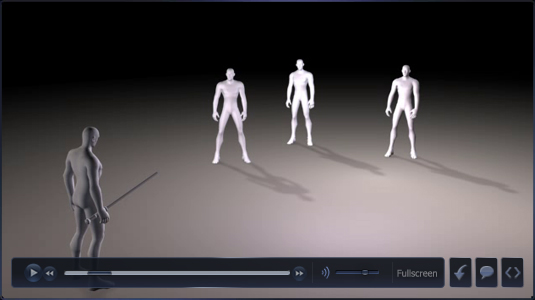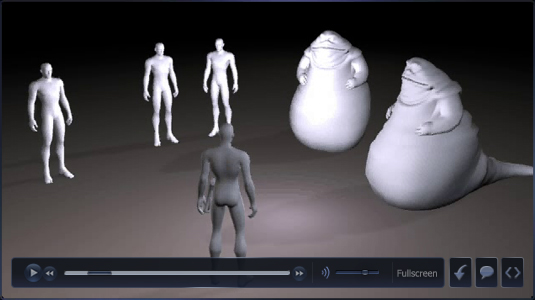News Articles
Studio Insider: Cinematic Animation
Introduction
Studio Insiders are designed to take you behind the scenes with the developers of Star Wars™: The Old Republic™. In this edition, Animator Andrew Lauretta explains how animations are created for in-game cinematics.
This week’s Community Q&A focuses on questions you had about Flashpoints. World Designer Jesse Sky has supplied answers with more details about these replayable multiplayer challenges. If you have a burning question about Star Wars™: The Old Republic™, don’t miss your chance to post a question in the new Community Q&A Thread!
Cinematic Animation
My name is Andrew Lauretta and I’ve been an Animator here at BioWare for almost 3 years. Today, I’m going to walk you through the process of creating the animation for one of the many memorable cinematics of Star Wars: The Old Republic.
To start off, the Animators get together with the Cinematic Designers to figure out what actions need to be recorded by the actors at the motion capture studio (you know, that place where people wear skin-tight suits with ping pong balls all over them). For this particular scene, we needed the player character to Force Push some guards away and slay a couple of Hutts. Each human’s action, from the player character thrusting his hand forward to the guards getting knocked to the ground, is then captured individually. You can’t exactly throw a human actor into a Jabba suit and expect to get a good result, so in this case the Hutts were animated by hand.
There are some crucial differences between motion captured animation and animating by hand. Motion capture is exactly what it sounds like: the actor's motion is captured using the suit and is translated into data that we can use to make our characters move. As a result, the animations we get are very natural and realistic. To animate something by hand means the animator will pose the character like they would an action figure. Essentially, we create a series of poses with a little help from the computer to smooth out the movement between poses.
Before we head to the motion capture studio for a shoot, we have to be very selective when choosing which actors we want to use. If we need to capture a lot of combat moves with Lightsabers, flips, jumps, and dives, we choose actors who are professional stunt persons. If we need more subtle motions and gestures for our conversations, we’ll go with someone whose strengths lie in acting. In addition to their skills, the actors must be of a similar size and frame as the characters in the game.
Once we receive that data back from the motion capture shoot, this is what we see:

Pretty rough, right? You’ll notice the Lightsaber barely stays where it needs to be, and it’s fairly obvious that the guards are jumping instead of getting knocked back by the Force. The timing is off between the actions, so some choreography is required as well. It takes some time to tweak and massage this data into something we can use, but it is much faster than trying to hand-animate these performances from scratch.
Once all of the human actions are lined up and working properly with each other, I move on to the Hutts. Since the player character is the catalyst for everything in this scene, it made sense to animate the Hutts last, taking into account the timing and positioning of the player character’s movements. For whatever reason, these two unlucky Hutts are about to be slaughtered by the player. For being such powerful and mighty crimelords, they can be downright cowardly when faced with their own mortality, so I animated them to act accordingly. After watching in horror as the guards get taken out, the first Hutt victim throws his hands up in a futile effort to stop his demise. There’s a little more time before the second Hutt is sliced open, so I have him try to make a run for it. Needless to say, he doesn’t get very far. Once I’m happy with how the Hutts are looking, I bring them in with the rest of the characters for a final review.

After this has been approved, our work is done and the animation is then given to the Cinematic Designers to put into the game. They place the characters in the actual environment and then add all the cameras and lighting to create the epic scene as it plays out if you decide to end these Hutts. Choose wisely…
Community Q&A
Each month we take time to answer some of the community’s questions about Star Wars: The Old Republic. If you have a question about one of the eight classes in The Old Republic, please post it in the new Community Q&A thread in the forums. We’ll be gathering questions from that thread on March 25, so be sure to ask your question before that date.
Today, World Designer Jesse Sky has answers to some of your questions about Flashpoints:
Q: Will Flashpoint for Republic and Empire ever meet? - Sirious_Nora
A: Certain Flashpoints, especially at the end game, are available to both factions. They represent threats so large that neither the Republic nor the Empire can afford to ignore them. Each side has its own quest givers, dialogue and motivations, though, so what you get are two very different looks at the same story.
Q: Are you thinking of introducing side-missions in Flashpoints where a specific class will be required to initiate/complete? - KrumStrashnii
A: We have considered adding some optional objectives that require certain classes or Crew Skills to complete. Of course, it’s a balancing act – how cool can you make it without forcing players to bring that ability set along every time? I’m interested in hearing what the community thinks; let us know your thoughts on the forums!
Q: How many hours of game time must players invest on average before their first Flashpoint is available to play with friends? - Fortunetek
A: You’ll encounter your first Flashpoint after your Origin World – how long you take to complete that is up to you, really. By this time, you’ll be familiar enough with your class to feel confident taking on content that requires a group.
Q: Are Flashpoints linear or can you go multiple routes without ruining the storytelling part? - Flopi
A: Your main objectives in a Flashpoint follow a clear path, except in cases where your story choices modify that path. We use bonus objectives to introduce elements of non-linearity, and we try to place surprises off the beaten path.
Q: How will loot be distributed in Flashpoints? - Trishot
A: Loot is distributed according to need/greed rules with a quality threshold set by the group leader. Players will also accumulate commendations that can be traded for special gear.
Q: Will it be possible to play a Flashpoint with fewer than four players, whether it's one, two, or three? - Mark
A: For early Flashpoints, you can certainly try, but as you get deeper into the game, you will need a full group of four players to have a reasonable chance of surviving the challenges in Flashpoints.
Q: How intricately will the boss fights in Flashpoints be scripted? A typical example would be nice. – Sungil
A: Bosses are scripted to match the fiction and the environments. They change phases and require players to think on their feet. Most of all they require coordination. An example off the top of my head is an Imperial officer who jumps behind cover and calls in a squad of soldiers with jetpacks. He then spends one stage of the fight sniping you and sending traps at you while his men arrive in waves.
Q: Will the choices a group makes (e.g. chosen dialogues, fight tactics, whether you killed enemies or not) have an impact on loot amount and quality at the end of a Flashpoint? - Elvasan
A: If your group decides to complete optional objectives, you will absolutely reap better rewards. Some of your story choices may result in different loot, but we never want group leaders enforcing story decisions or bailing out halfway because the ‘wrong’ decision was made, so we avoid associating key rewards with story choices. We want you to be free to roleplay.
Q: How do you intend to make replaying Flashpoints interesting (other than using diverse loot tables) in order to encourage group play and to not have Flashpoints deteriorate into "farm areas" typical of other games in the genre? - TheOrigin
A: From a gameplay perspective, we try to keep the combat mechanics dynamic and the pacing strong. We’ve discussed adding elements that differ from one session to the next, but our top priority is offering a diverse array of Flashpoints at launch. As a BioWare fan, I find the stories alone engaging enough to repeat – especially with the multiplayer conversation system.
Q: How exactly will class roles inside Flashpoints work? Will it be like in WoW or similar systems with fix systems, in which only damage dealer can deal damage, in which only tanks can block and only healer can heal? - Sarnave
A: This is an area where we try to distinguish Flashpoints from dungeons. While boss fights often require traditional tank and healer roles, some sections of Flashpoints are paced in such a way that healers can switch into damage roles and tanks can get a bit more reckless.
Q: Do mobs respawn in a Flashpoint after a certain time, or do they "stay" dead? - MilOuZ
A: Enemies do not respawn in Flashpoints. The story is too tightly focused for respawning enemies to make sense, and it would have undesirable gameplay consequences.
Q: Are classes adaptable enough in order to complete a Flashpoint with a any group (e.g. 4 Jedi Consulars, possibly with the help of certain companions)? - Ashlack, Akbar
A: You will need a well-balanced group to complete a Flashpoint. You’ll find some very unique and powerful combinations of Advanced Classes, but if you stack several players with the same role, you’re not likely to fare well.
Q: What happens in Flashpoints in case of a wipe in terms of scenario? Do we have to replay the Flashpoint story from the beginning? - Askanir
A: If your group wipes, you’ll just need to run back from your most recent objective. You will not lose any story progress unless your group leaves the instance and lets its timer expire.
Q: When we reach max level, will it be possible to solo low-level Flashpoints? - Yanis Micropoulos
This is something that we are looking into with in-game testing. A very skilled player probably could.
Thanks for joining us for this Studio Insider! We hope you enjoyed taking a look into the development of Star Wars: The Old Republic. If you have any questions for the next Community Q&A focused the eight class in the game, please post them in the new Community Q&A thread. In every Studio Insider, we’ll answer more questions directly from the community. Please keep your questions courteous. We ask that you only post one question in the thread, and that you try to avoid duplicating questions that have already been asked. Keep in mind that we can’t talk about everything just yet, so please don’t feel offended if your question isn’t selected.



